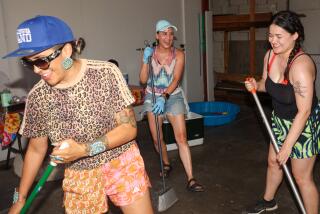Pentecostals Plan to Honor Birthplace of Their Movement
Pentecostal Christians are not known for putting much stock in shrines, but a little house near MacArthur Park in Los Angeles may soon be given the recognition due it as the place where the worldwide growth of Pentecostalism began 91 years ago.
It was on April 9, 1906, that a fiery African American preacher by the name of William J. Seymour began proclaiming the Gospel from the front porch of 216 N. Bonnie Brae St., attracting growing multiracial crowds that spilled into the street.
Soon there were reports of speaking in tongues, healings and other miracles that drew such large crowds that Seymour was forced to relocate to Azusa Street in what is now Little Tokyo. The site became the vortex of an ecstatic Pentecostal expression of Christianity--known as the Azusa Street Revival--that was to spread throughout the world and spawn the formation of major denominations.
Today, pastors of those denominations will announce a new plan to restore Bonnie Brae House to its rightful place in the history of Pentecostalism, which now boasts an estimated 300 million believers worldwide, not counting charismatics in other branches of Christianity. Church officials are in the process of acquiring two adjacent properties, and plans call for making the residence a kind of Pentecostal mecca--a house of prayer. There are also plans for parking, a bookstore and an interpretive center.
The house is owned by the First Jurisdiction (diocese) of the Church of God in Christ headed by Bishop Charles E. Blake, pastor of the West Angeles Church of God in Christ on Crenshaw Boulevard.
“It is the birthplace of the major Pentecostal revival that was the source of most of the Pentecostal denominations in the U.S. today,” Blake said in an interview.
Pastor Jack Hayford of the Church on the Way in Van Nuys and a national leader in the move to bring racial reconciliation between African American and white Pentecostals is equally enthusiastic.
“The establishing of an historical site that will secure the birthplace of what’s become the global phenomena of the spread of the Gospel through the Pentecostal movement will be a milestone in the faith,” Hayford said.
That African American, white and Asian denominations are joining in the effort harks back to the multiethnic roots of Pentecostalism. But the racial unity in the early days was short-lived. Soon after the Azusa Street mission was established, it was shaken by public ridicule and outrage--as much over the group’s interracial character as its unconventional style of ecstatic worship. Within months, members of the mission left and formed what have become today major Pentecostal denominations that have largely been divided along racial lines.
But three years ago in what came to be known as the “Memphis Miracle,” leaders from major racially separated Pentecostal denominations and independent churches disbanded their separate umbrella associations and organized a new multiethnic organization known as the Pentecostal Fellowship of North America.
The house is to some a symbol of reconciliation. One of Blake’s ministers, Fred Berry, called the house “a physical manifestation of the unity we’ve all been talking about. This would be a rallying point for the body of Christ,” Berry said. “This is the thing that God did for us at a unifying level 91 years ago. We should honor this. It’s a memorial to the Lord.”
Berry said Pentecostals plan a major rally May 17 at the Bonnie Brae house in association with the annual March for Jesus.
Besides Blake, Berry and Hayford, others scheduled to participate in today’s press conference are the Rev. Harold Helms of Angelus Temple, U.S. Senate chaplain Lloyd Ogilvie, the Rev. Jim-Bob Park of Young-Nak Presbyterian Church, the Rev. Che Ahn of Harvest Rock Church, Raimundo Jimenez of the Hispanic Christian Communications Network, the Rev. Samuel F. Meza Jr. of Living Hope Community Church and the Rev. Kenneth C. Ulmer of Faithful Central Missionary Baptist Church.
More to Read
Sign up for Essential California
The most important California stories and recommendations in your inbox every morning.
You may occasionally receive promotional content from the Los Angeles Times.










